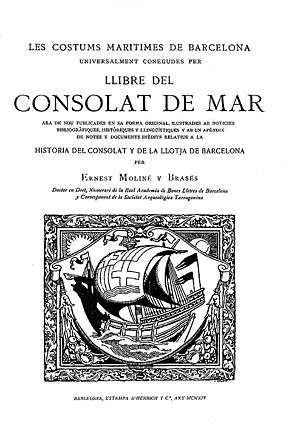Consulate of the Sea facts for kids

The Consulate of the Sea (in Catalan: Consolat de mar) was a special group or court that helped manage rules for sea travel and trade. It started in the Crown of Aragon, which was a powerful kingdom in what is now Spain. Over time, this idea spread to other places around the Mediterranean Sea.
The name "Consulate of the Sea" can also mean a famous collection of rules and customs for ships and trade. These rules were written down in the Catalan language during the 1300s and 1400s. They were first published in Valencia around 1494.
Today, the Catalan term Consolat de mar is still used. It refers to a service in Barcelona that helps solve business disagreements. It also refers to offices that help promote trade for the city of Barcelona.
Contents
What Was the Medieval Consulate of the Sea?

The idea for the Consulate of the Sea in Catalonia began in 1258. That year, King Jaume I of Aragon gave the city of Barcelona a special permission called the Carta Consular. This permission allowed Barcelona's merchants to solve their trade problems without the king's regular courts getting involved. In return, the king received important money to help pay for his wars.
At the same time, special laws for merchants (called ius mercadorium) were becoming common across Europe. Similar groups had already been set up in places like Messina (early 1200s) and Genoa (1250).
As the Crown of Aragon grew and took over more lands, new Consulates of the Sea were often created in important ports. One of the first was in Valencia in 1283. The rules for this new consulate clearly stated that disagreements should be settled "according to maritime customs, as these are accepted in Barcelona." This showed how important Barcelona's rules were.
The Famous Book of the Consulate of the Sea
The full name of this important book in Catalan is Les costums marítimes de Barcelona universalment conegudes per Llibre del Consolat de mar. This means "The maritime customs of Barcelona universally known as the Book of the Consulate of the Sea."
The oldest printed copy we know of was made in Barcelona in 1494. It doesn't have a title page, but its introduction calls it by the long name above. This special copy is kept in the Bibliothèque nationale de France in Paris. The introduction also says that the book was updated by Francis Celelles with help from many experienced ship captains and merchants.
There are also older handwritten copies of parts of the book. Some of these date back to the 1300s and 1400s. This shows that the rules were being used and written down for a long time before they were printed.
What's Inside the Book?
The 1494 edition of the book has several main parts:
- First, it has a set of rules from the kings of Aragon. These rules guided how the courts of the Consuls of the Sea should work.
- Second, it includes a collection of old customs for sea travel and trade.
- Third, it contains rules for how warships should operate.
At the end of these main rules, a note says that this is where the "Book of the Consulate of the Sea" officially ends. After this, there's a section called "The Acceptations." This part claims that the rules were approved by different groups and leaders centuries ago, but historians generally don't believe this part is historically accurate.
How the Book Spread
The original Book of the Consulate of the Sea, along with extra rules added later, became very popular across Europe. In the 1500s, it was translated into Castilian (Spanish), Italian, and French. The Italian translation, printed in Venice around 1549, was especially widely read. This led many legal experts to mistakenly think the book was originally from Italy.
Later, in the 1600s, the book was translated into Dutch and German. It is also believed to have been translated into Latin. These many translations show how important and influential the Book of the Consulate of the Sea was for maritime law and trade across different countries.
See also
 In Spanish: Consulado del Mar para niños
In Spanish: Consulado del Mar para niños


